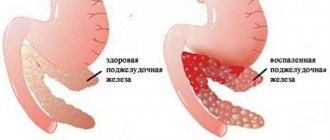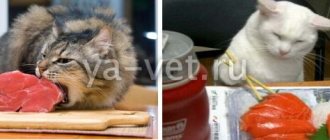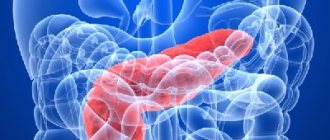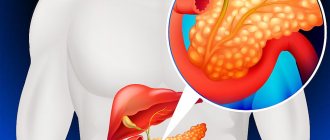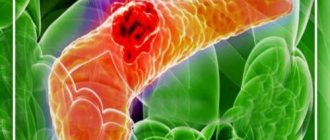Veronica Igorevna Sharipova
veterinarian Petstory
Feline pancreatitis as an independent disease is a fairly rare pathology. Oddly enough, there are many myths and prejudices around this disease. For example, it is believed that if a cat has acute or chronic vomiting, then he has pancreatitis and needs a low-fat diet. But this is not at all true. We will look at the features of pancreatic inflammation in cats in this article.
The pancreas is a unique organ in the body, which is a gland of both exogenous and endogenous secretion. The exocrine function ensures optimal digestion of food and absorption of nutrients in the intestine and consists of the production of special digestive enzymes (trypsin, lipase, amylase). The endocrine function of the pancreas is to maintain glucose levels in the body and is ensured by the production of the hormone insulin. Thus, inflammation of the pancreas - pancreatitis - is a dangerous disease that affects the functioning of the entire body.
According to a new large study conducted on 6504 cats, it was found that only in 0.6% of cases the death of cats was caused by pancreatitis, and in 0.4% of cases the disorders were characteristic of chronic pancreatitis, and in 0.2% of cases - for acute. Thus, the rare intravital diagnosis of this disease is associated with difficulties in making a diagnosis and a fairly rapid fatal outcome for the pet.
Pancreatitis in cats is a dangerous and very common disease.
The danger of the pathology is that the disease is difficult to identify immediately - pancreatitis has vague symptoms.
And to make an accurate diagnosis, it is necessary to carry out a series of complex manipulations and tests. Therefore, every cat owner should know the causes, symptoms, methods of treatment and prevention of this pathology. Pancreatitis is a malfunction (inflammation) of the pancreas, which is responsible for normal digestion. In healthy cats, pancreatic enzymes begin to break down fats from food only in the duodenum. In those who are sick, enzymes are activated in the gland, and it begins to “digest” itself. The toxins produced during this process poison other internal organs.
This gland is also responsible for the production of the hormone insulin, which is necessary to saturate cells with glucose. A malfunction in its operation leads to an uncontrolled release of sugar into the blood. Therefore, in advanced cases, pancreatitis in a cat can develop into a complex pathology - diabetes.
There are two forms of the disease: acute and chronic. These forms differ from each other in flow speed.
Forms and their features
Pancreatitis in cats occurs in various forms, differing in the main signs and consequences for the whole organism:
- Acute. The main feature is that attacks of pancreatitis occur suddenly. They cause severe pain and usually develop immediately after eating.
- Chronic. Develops gradually, but leads to irreversible consequences. Characterized by lethargy and mild clinical signs.
The greatest danger is acute pancreatitis. He requires immediate attention to the veterinarian!
Chronic pancreatitis
This form of the disease is more dangerous and insidious. Pancreatitis slowly develops and “destroys” the cat’s body. Without any noticeable symptoms, the animal gets worse and worse. A chronic process can develop for years, and the owner of the animal will not know about it - this is its main danger.
The disease is indicated only by changes in the pet's behavior (the animal becomes lethargic and drowsy), incessant rumbling in the stomach, dulling of the fur and yellowish stools.
Causes
It is difficult to independently determine the cause of the disease. This will require in-depth medical research in a veterinary clinic. In complex cases, surgery may be required.
Main reasons:
- Pathologies in the structure of the organ and congenital developmental anomalies.
- Errors in power mode. You should not give cats fatty foods: lard, fatty meat and fish. It is unacceptable to feed food from the human table: canned food, sausages, smoked meats, spicy food. An attack of pancreatitis can be triggered by a sudden change in food.
- Intoxication of various etiologies.
- Hormonal diseases: various pathologies of the thyroid gland, diabetes mellitus, Cushing's syndrome, etc.
- Poisoning with household toxic substances: petroleum products, fertilizers, rat poison.
- Poisoning with medications: diuretics, hormonal, antibacterial. Common medications such as Furosemide and Aspirin can be dangerous for cats.
- Hypercalcemia.
- Obesity or severe malnutrition.
- Gastrointestinal diseases: gastritis, liver cirrhosis, cholecystitis, etc.
- Infection with helminths.
- Viral, fungal and bacterial infections.
- Trauma and mechanical damage to the abdominal cavity, unsuccessful surgical interventions (laparoscopy).
- Diabetes.
There are many reasons why pancreatitis occurs, so owners need to know its symptoms in order to promptly seek diagnosis and treatment from a veterinarian.
Symptoms of pancreatic inflammation
As we have already said, the pathology has vague symptoms - it is difficult to immediately make a correct diagnosis.
- Profuse diarrhea is sudden, uncontrollable diarrhea.
- Dyspeptic symptoms - rapid saturation, heaviness in the stomach.
- Vomit. Most often it appears in advanced forms of the disease and during exacerbations.
- Cat feces have an unpleasant, sour smell. They contain particles of undigested food.
- Chronic constipation.
- Dehydration: dull, brittle coat, decreased muscle tone, dry skin and mucous membranes.
- Severe pain syndrome. The animal is worried, meows loudly, screams. Doesn't allow you to touch his stomach - he might bite.
- Hard belly.
- The animal hides in secluded places, avoids active games and communication with people, and becomes apathetic and lethargic.
- In the acute form of the disease, an elevated temperature appears.
- Jaundice color of mucous surfaces.
- A sharp decrease in appetite, exhaustion, anorexia.
- Lethargy.
- Respiratory failure: tachypnea (rapid breathing), shortness of breath.
Other symptoms of pancreatic inflammation are also possible. In the acute form of the pathology, the picture of the disease is clearly expressed. The chronic form is sluggish, the picture is blurry.
Symptoms of the disease
Pancreatitis in the initial stages is practically asymptomatic, so it is difficult to detect it at home.
Among the main symptoms:
- sluggish and apathetic state,
- diarrhea,
- temperature increase,
- sudden weight loss,
- dehydration,
- lack of appetite,
- belly hard to the touch
- icteric mucous membranes,
- general weakness.
Note! Typically, an attack of vomiting or diarrhea is observed 10-15 minutes after the animal eats food.
Are you observing one or more signs in your pet? Do not hesitate, contact a veterinary clinic for professional help. The sooner pancreatitis is diagnosed, the faster and more effective its treatment!
Methods for diagnosing pancreatitis in cats
Diagnosis of pancreatitis is possible only in a specialized clinic; the following methods are used for this:
- Ultrasound of the abdominal organs. Determines swelling of the gland, changes in the echogenic pattern of the affected organ, and inflammatory phenomena.
- Blood tests: clinical and biochemical. They show excess levels of liver enzymes, glucose and bilirubin levels, cholesterol, ALT, alkaline phosphatase. Biochemistry reveals hypocalcemia and hypokalemia. Clinical blood test – non-regenerative anemia.
- Rapid test for pancreatic lipase.
- Biopsy and histopathology are the most informative methods. They make it possible to distinguish the acute form from the chronic one, to detect fibrosis, edematous phenomena, parenchymal tissue necrosis, and ductal hyperplasia.
Please note: due to the difficulty of timely diagnosis, most animals cannot be definitively diagnosed until after necropsy. That’s why it’s so important to be attentive to your pets and show them to veterinarians at the first suspicious symptoms.
Complications and consequences
High mortality in the acute form is associated with early complications arising from the inflammatory process. It leads to thrombosis, internal bleeding, liver and respiratory failure.
With a prolonged course of the disease, the likelihood of developing oncology and the appearance of fistulas increases. The body's defenses gradually decline, so it becomes vulnerable to pathogenic microorganisms. In the event of a secondary infection, not only the pancreas suffers, but also the nearby intestines and other neighboring tissues. This leads to purulent abscesses, fraught with the appearance of sepsis. With this outcome, the animal may die from blood poisoning.
Another dangerous complication is pancreatic necrosis. This pathology is accompanied by the death of tissue of the affected organ and loss of its functionality. Enzymes and breakdown products entering the bloodstream aggravate intoxication. Not only the immediate organs are in danger, but also the heart and brain. In 90% of cases, pancreatic necrosis is incurable.
With late treatment, the acute form develops into a chronic form. Like pancreatic necrosis, it is incurable. Treatment is based on symptomatic therapy, lifelong diet and regular prevention.
Treatment of pancreatitis in cats
Treatment in each individual case is prescribed individually after an accurate diagnosis has been established and concomitant diseases and symptoms have been identified.
The therapeutic strategy is selected taking into account the complexity of the course, stage, form and neglect of the pathological process. Self-medication is unacceptable!
- Starvation diet for 1-3 days to reduce the enzymatic functions of the diseased gland.
- Infusion therapy to combat dehydration. The drugs used are: 0.9% saline solution, Ringer's solution, Dextran-70.
- Antispasmodic and painkillers: Spazgan, No-shpa, Baralgin, Papaverine, etc.
- Antiemetics: Metoclopramide, Maropitant, Cerucal, Chlorpromazine.
- Heart remedies: Camphor, Cordiamine.
- Enzymes: Pancreatin.
- In acute pancreatitis, Gordox is prescribed to reduce the secretion of digestive enzymes.
- Animals with anorexia are fed through a nasoesophageal tube or PEG tube. Mirtazapine is used to stimulate appetite.
- In case of complications, a plasma transfusion or a complete blood transfusion is prescribed.
- A course of antibacterial therapy is indicated only to prevent septic phenomena.
- In the most severe cases, laparoscopy is performed to remove the necrotic part of the affected organ.
For the most effective treatment, it is important to identify the disease as early as possible.
Diagnosis and treatment
It is impossible to establish an accurate diagnosis based on the description of symptoms, because these same signs may indicate other diseases of the gastrointestinal tract.
The veterinary clinic conducts additional examination:
- ultrasound examination of the abdominal cavity, which reveals swelling of the pancreas, its displacement relative to other organs, and determines its size;
- pancreatic biopsy;
- blood chemistry;
- Analysis of urine.
This examination allows you to identify or exclude other concomitant diseases and determine the cause of pancreatitis.
After this, treatment begins. If the form of pancreatitis is mild, then it is often enough to eliminate the cause, prescribe painkillers and prescribe a diet.
In case of severe disease, in addition to the above therapy, the following is prescribed:
- drugs for the treatment of concomitant diseases (cardiovascular system, diabetes, other gastrointestinal diseases);
- antiemetics;
- pancreatic enzymes;
- IVs to prevent dehydration;
- antibacterial or anti-inflammatory drugs (according to urine and blood tests).
After the course of treatment, a repeat ultrasound is performed, blood tests are taken and weight is monitored. Regardless of whether the cat is obese or malnourished, a special diet is prescribed. Proper feeding will help restore pancreatic function.
Medical nutrition
After diagnosis and all therapeutic measures, sick cats are prescribed a therapeutic diet.
In the first days after therapeutic fasting, only liquid mucous porridges with water are allowed: Hercules, buckwheat, rice. Gradually, it is allowed to supplement the diet with steamed egg white omelettes, vegetable purees (zucchini, carrots) and low-fat lactic acid products (yogurt, kefir and cottage cheese). The food should be warm. Give it in small portions 5-6 times a day.
Industrial feed
Animals that are accustomed to dry food are prescribed medicinal food of the “super-premium” and “holistic” classes for life.
Their formulas consist of easily digestible ingredients and contain moderate amounts of fat and protein.
Medicinal foods for pancreatitis:
- Royal Canin Gastro Intestinal Moderate Calorie;
- Hill's i/d;
- Eukanuba Intestinal;
- Purina EN.
What is prohibited to feed:
- raw vegetables and fruits;
- smoked products;
- whole milk;
- fatty meats and fish;
- canned food, salty foods;
- sweets;
- bakery products;
- strong meat broths;
- fatty fermented milk products;
- cereal products;
- industrial feed of the "economy" class;
- dry food containing corn.
A therapeutic diet promotes a speedy recovery of the animal and prevents relapse.
Mr. Cat warns: pancreatitis and relapses
A cat that has had pancreatitis remains at risk of recurrence of the disease throughout its life. Any, even minor, negative factor can cause a recurrence of the pet’s pathological condition.
To eliminate the risk of developing the disease, they adhere to strict rules in the animal’s diet. Avoid fried foods and ensure that calcium levels in industrial feeds are not exceeded.
Do not allow the animal to overeat or starve, provide it with constant access to clean drinking water.
It is also necessary to ensure sanitary treatment of the premises where the cat lives. Regular medical examination and deworming are also considered a prerequisite for the health of a pet.
Prevention
- Follow the vaccination schedule, regularly deworm and do not neglect preventive examinations.
- Strictly adhere to the diet, monitor the quality of food and ready-made commercial feed, and stop attempts at home to “treat” your pet with food from the table.
- Monitor your pet's weight and prevent obesity.
- Strictly adhere to the recommendations of veterinary specialists during treatment of chronic pancreatitis in the acute phase and during remission. Do not replace medications or change dosages of medications.
- Get rid of all poisonous houseplants.
- Place household chemicals out of the reach of cats.
Strict adherence to these simple rules will help your pet stay healthy longer.
Factors predisposing to pancreatitis
Speaking about the propensity of certain cats to pancreatitis, it is worth noting that it, among other things, depends on the breed. For example, Scottish cats (Scottish Folds, Scottish Straights, Highland Folds and Highland Straights) do not have a breed tendency to pancreatitis, but Siamese, Thai, Balinese, and Orientals suffer from it more often than others.
A small number of cases of the disease are associated with congenital pathology, poisoning, trauma, infection, pancreatic and liver worms, infectious peritonitis, calicivirus and lipodystrophy.
However, the main predisposing factor to pancreatitis is improper nutrition: excessive, rich in carbohydrates, too frequent and uncontrolled, when the cat has constant access to an unlimited amount of food. Considering that most owners feed their cats incorrectly, one should not be surprised at the appearance of pancreatitis.
Often cats end up in the clinic with pancreatitis after the holidays, when the owners cook a lot of tasty things and treat their pets, or the cats themselves steal from the table.
